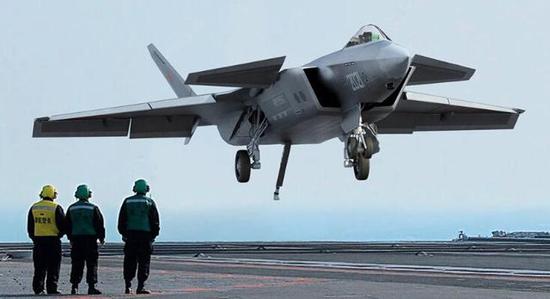 |
Naval J-20 – Image: china-arms.com
|
The J-20 may not be strong enough to take off from or
land on the Liaoning, and the fighter is too big for the carrier's hangar, a
PLA admiral says
By ASIA TIMES STAFF NOVEMBER 24, 2017
2:18 PM (UTC+8)
Chinese party mouthpieces have been set into operation,
playing up the might of the J-20, the People’s Liberation Army Air Force’s
fifth-generation “air supremacy” stealth fighters. But some papers have gone a
bit overboard, suggesting the planes are capable of swift deployment on the
Liaoning, the PLA’s first aircraft carrier, and the second carrier that is
expected to undergo sea trials shortly.
That assertion, obviously a step too far, has received
some derisive reactions from professional observers at home and abroad, so much
so that state broadcaster CCTV has to rectify matters.
In a program aired on its International Mandarin channel,
PLA Rear Admiral Zhang Zhaozhong, also a well-known military commentator,
admitted that putting J-20 on carriers was rather “contrived”, as the fighters
were never designed to be carrier-based aircraft.
“J-20’s structural design and components are all intended
for use as a land-based warplane and thus its structural strength may not have
been reinforced for take-off from or landing on a carrier, as in these
circumstances the plane would have to withstand huge counterforce and inertia,”
Zhang said.
Nor are J-20’s wings foldable, to enable it to be parked
in the hangar below the carrier’s flight deck, as space is always at a
premium on a sea-going airbase.
Unlike the F-35 Lightning IIs, J-20 may not need to be
maintained in a hangar with a constant temperature and humidity, as revealed in
a previous CCTV report. Yet its delicate stealth coatings may be rendered
dysfunctional when exposed to an offshore environment with high salinity and
high humidity.
Still, the J-15 carrier-based fighters have entered mass
production after technicians for Aviation Industry Corp of China reportedly
took just two months to solve technical hurdles, paving the way for the
fighter’s successful arrested landing tests in November 2012, just months after
the Liaoning was inaugurated.
The J-15 has twelve external hardpoints for munitions
including air-to-air, anti-ship and anti-radar missiles, and can cruise at a
maximum speed of 2.4 Mach (2,940 kilometers an hour) with a range of 3,500 km
and maximum takeoff weight of 32.5 tons.
This year the Liaoning returned to the South China Sea
after it was initially deployed in the western Pacific. The carrier
conducted a series of take-off and landing drills with its J-15 fighters,
following a fatal accident in 2016 in which a J-15 crashed during a simulated
carrier landing.
Analysts say the J-15 is almost on par with the US Navy’s
Grumman F-14 Tomcat supersonic, twin-engine fighter aircraft. The Tomcat was
retired from service in September 2006, having been supplanted by the Boeing
F/A-18E/F Super Hornet.
Original post: atimes.com
Related articles:
Chengdu J-20: Details
Shenyang J-15: Details
No comments:
Post a Comment